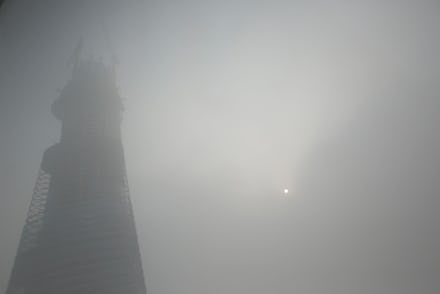Wild Pictures Of China's Worst Smog Day in History

The news: Smog in China is out of control. On Friday, these were the scenes that greeted Shanghai residents as they woke from their beds, courtesy of two Reddit users:
No, those aren't screenshots of Steven King's The Mist. That's what happens when pollution-induced fog in one of the world's largest cities literally goes off the charts. According to one Redditor, the lung-disease-inducing smog was so bad that it could even be seen flooding down school hallways.
From Redditor Zydoran's commute to work:
For context, Shanghai's air-quality index exceeded the maximum reading of 500 this week. The indexes below explain what this means:
So Shanghai has gone past yellow, orange, red, purple, and even maroon alert. The level of microparticulates in the air is more than 16 times the safety limit the Environmental Protection Agency sets for an average 24-hour period. It's so bad that 98 flights out of Shanghai's two airports were delayed, and 89 were canceled.
Shen Lan, an airport manager, said "It's too hazardous to let [her five-year-old son] go to the kindergarten on such a smoggy day."
"I have kept the air purifier working at home all day and night ... But that's not enough. I'm going to buy strips to have the windows and doors sealed."
Why is this happening? China has a very poor record on environmental regulation, and Shanghai has 24 million residents. The staggering smog is an inevitable confluence of urban migration and insufficient measures to curb pollution. Even state-run newspaper China Daily declared in early 2013 that China's major cities were rapidly becoming "barely suitable for living."
According to NPR's Frank Langfitt, the problem isn't necessarily cities themselves. City officials in Beijing have been using tools at their disposal to combat the rising levels of smog, including by setting high fuel emission standards and replacing coal-burning heating with natural gas. Neighboring Hubei province, however, which surrounds much of Beijing, has much lower standards for emissions and has thousands of dirty factories. When the wind blows in the wrong direction, smog flows right into downtown. Despite being a highly authoritarian regime, the Chinese government is still massively decentralized, and regional officials often aren't willing to cooperate.
Chinese officials are trying to solve the problem; Sinopec Chairman Fu Chengyu set a new national standard that might relieve as much as 90-99% of sulfur emissions from fuel. But it could take more than four and a half years to implement.